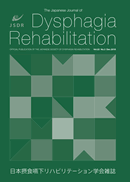Volume 9, Issue 2
The Japanese Journal of Dysphagia Rehabilitation
Displaying 1-14 of 14 articles from this issue
- |<
- <
- 1
- >
- >|
Original Paper
-
2005Volume 9Issue 2 Pages 127-138
Published: August 31, 2005
Released on J-STAGE: December 26, 2020
Download PDF (4677K) -
2005Volume 9Issue 2 Pages 139-147
Published: August 31, 2005
Released on J-STAGE: December 26, 2020
Download PDF (4043K) -
2005Volume 9Issue 2 Pages 148-158
Published: August 31, 2005
Released on J-STAGE: December 26, 2020
Download PDF (4380K) -
2005Volume 9Issue 2 Pages 159-165
Published: August 31, 2005
Released on J-STAGE: December 26, 2020
Download PDF (2960K) -
2005Volume 9Issue 2 Pages 166-171
Published: August 31, 2005
Released on J-STAGE: December 26, 2020
Download PDF (2128K) -
2005Volume 9Issue 2 Pages 172-179
Published: August 31, 2005
Released on J-STAGE: December 26, 2020
Download PDF (3131K) -
2005Volume 9Issue 2 Pages 180-185
Published: August 31, 2005
Released on J-STAGE: December 26, 2020
Download PDF (2651K)
Clinical Report
-
2005Volume 9Issue 2 Pages 186-194
Published: August 31, 2005
Released on J-STAGE: December 26, 2020
Download PDF (3978K)
Research Report
-
2005Volume 9Issue 2 Pages 195-198
Published: August 31, 2005
Released on J-STAGE: December 26, 2020
Download PDF (1673K) -
2005Volume 9Issue 2 Pages 199-205
Published: August 31, 2005
Released on J-STAGE: December 26, 2020
Download PDF (2914K) -
2005Volume 9Issue 2 Pages 206-212
Published: August 31, 2005
Released on J-STAGE: December 26, 2020
Download PDF (2957K) -
2005Volume 9Issue 2 Pages 213-220
Published: August 31, 2005
Released on J-STAGE: December 26, 2020
Download PDF (3195K) -
2005Volume 9Issue 2 Pages 221-227
Published: August 31, 2005
Released on J-STAGE: December 26, 2020
Download PDF (2946K) -
2005Volume 9Issue 2 Pages 228-233
Published: August 31, 2005
Released on J-STAGE: December 26, 2020
Download PDF (2436K)
- |<
- <
- 1
- >
- >|
